This page contains abbreviated entries for:
- Deutsche Jahre
- 1914: Ein Maler zieht in den Krieg
- wave and smile
- Madgermanes
- Das Tagebuch der Anne Frank
This page contains longer entries for:
- Berlin: Gleis Dreieck
- Berlin: Steinerne Stadt
- Deutschland. Ein Bilderbuch
- Die Entdeckung der Currywurst
- Der erste Frühling
- Liebe schaut weg
- Die Sache mit Sorge: Stalins Spion in Tokio
- Der Tod von Adorno
- Die Welle
- Zweite Generation: Was ich meinem Vater nie gesagt habe
Abbreviated entries
Natter, Jens. Deutsche Jahre: Witzige Wimmelbilder zur deutschen Geschichte. Schaltzeit Verlag, 2012.

Kleist, Reinhard. 1914: Ein Maler zieht in den Krieg. Aladin, 2014.
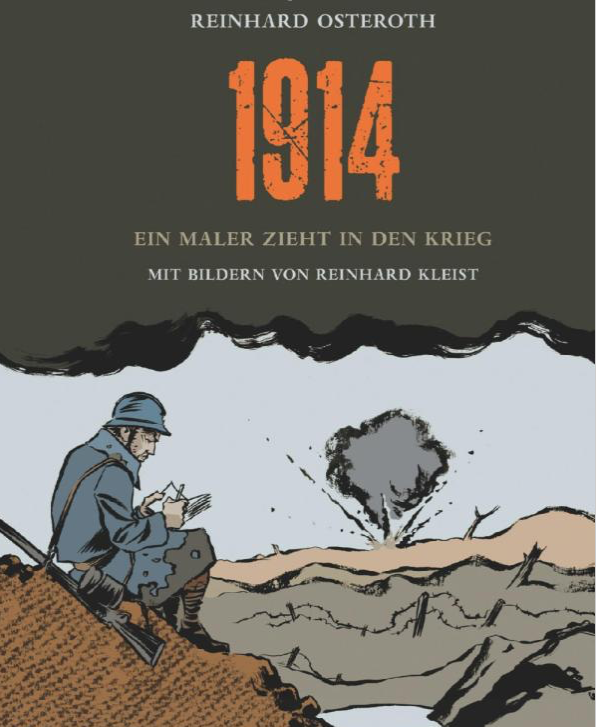

Jysch, Arne. wave and smile. Carlsen, 2014.


Weyhe, Birgit. Madgermanes. avant-verlag, 2016.


Interview with the author/artist
Folman, Ari. Das Tagebuch der Anne Frank. S. Fischer, 2017.
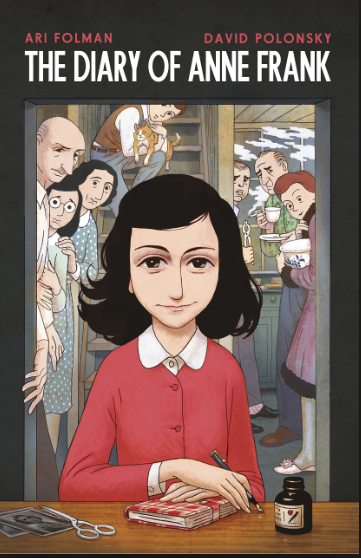

Ulbert, Jörg and Jörg Mailliet .Berlin: Gleis Dreieck. Berlin Story Verlag, 2013.
ISBN: 978-3-95723-029-4
Lutes, Jason. Berlin: Steinerne Stadt. Hamburg: Carlsen Verlag, 2003.
ISBN: 978-3551766748
Guest Review by David Wildermuth, Assistant Professor of German, Shippensburg University.
Berlin: Steinerne Stadt is the first installment of a planned trilogy depicting life in Berlin between September 1928 and May 1929. Through a series of evolving personal relationships involving characters across the socio-economic spectrum, readers learn of life in Germany’s capital during the late Weimar Republic as well as the choices Berliners were confronted with while navigating the political, economic and social unrest of the day. The sense of realism is heightened by both the black and white illustrations as well as the phonetic depiction of each character’s speech which corresponds to his/her relative social status. For instance, the bubble captions of the communist and Nazi street fighters and their families are written in Berlin dialect.
The violence as well as the occasional nudity portrayed makes this graphic novel better suited to college-level students. The novel especially lends itself to conversation courses, as students are exposed to formal and non-formal modes of expression, although the written dialect referred to above will require further explanation. The portrayal of the rise of Nazism as less than a foregone conclusion will also lend itself to culture courses seeking a better understanding of this often neglected topic.
Kreitz, Isabel. Deutschland. Ein Bilderbuch. Köln: DuMont Buchverlag.
ISBN-13: 978-3-8321-9621-9
The book consists of one page comic interpretations of events in German history, some mainstream, some more obscure. On the left hand page of each entry, Kreitz offers a brief summary or introduction to the graphic page.
Sample Text: Kreitz’s caption: “Manns erste Deutschlandvisite. 1949. Erstmals nach 16 Jahren im Exil besucht der Schriftsteller Thomas Mann Deutschland, um am 25. Juli in Frankfurt den Goethe-Preis der Stadt entgegenzunehmen. Eine Woche später erhält er in Weimar den eigens ins Leben gerufenen Goethe Nationalpreis der DDR und hält die Frankfurter Rede noch einmal.”
From the first frames of the accompanying comic page featuring Thomas Mann: “…ich kenne keine Zonen, mein Besuch gilt Deutschland selbst, Deutschland als ganzem und keinem Besatzungsgebiet! Wer sollte die Einheit Deutschlands gewährleisten und darstellen, wenn nicht ein unabhängiger Schriftsteller dessen wahre Heimat, wie ich sagte, die freie, von Besatzungen unberührte deutsche Sprache ist.”
Instructors could use these single pages to supplement other cultural or historical information learned in class. For example, one page features women talking about the newly granted Frauenrechte. Students could describe the visual aspects picture and then move on to answering questions about this page as an episode in the history of women’s rights in Germany. Finally, students could move on to analyses of the pages as works of art and interpretations in their own right.
 There is nothing objectionable in the subject matter, but some of it is written at a high linguistic level or requires extensive cultural knowledge.
There is nothing objectionable in the subject matter, but some of it is written at a high linguistic level or requires extensive cultural knowledge.
Kreitz, Isabel. Die Entdeckung der Currywurst. Carlsen, 2005.
ISBN 13: 978-3551781833
To learn the origin of this popular German sidewalk food, most commonly attributed to the city of Berlin, the narrator tracks down Lena Bruckner in a retirement home. She admits that it was her invention but it’s a long story, one which he convinces her tell over tea. It all started in April 1945 when she met, seduced, and held a young deserter captive. With the war now over, the lover escaped and Lena into the sausage business.
Kordon, Klaus and Christoph Heuer. Der erste Frühling. Carlsen, 2007.
ISBN 13: 978-3551737878
Sample Text: ,,Hallo Änne, spielste mit?” ,,Was spielt ihr denn?” ,,Häuser treffen!” ,,So was spielt man doch nicht!” ,,Wieso denn nicht, ist doch nicht echt…” [Änne gets in the way of an NS officer] Officer: ,,Du verfluchte KZ-Göre” ,,Ich verstehe nicht was…” ,,So was wie du gehört weggesperrt wie deine Eltern.”
Spring 1945. The Allies finish bombing Berlin and the Red Army keeps getting closer. 12 year old Änne experiences the end of the war and the invasion of the Red Army at her grandparents’ who have been raising her since her parents were arrested. One day a man appears at the door: it is Änne’s father who has survived Buchenwald.
The graphic novel opens with a letter from Klaus Kordon to Christoph Heuer, the graphic novelist. He expresses his initial skepticism at having his novel turned into a graphic novel, and admit that he questioned how the graphic novel could capture the horrific incidents without “mutating it into an action-adventure.” He was favorably impressed with the final product and fully endorses it. The letter could be used in a discussion of the strengths and limitations of graphic texts.
The novel does in fact portray various pictorial frames from the war, including bombings and KZ prisoners, but accomplishes this in a documentary rather than a sensationalist style.

 Because of some of the graphic scenes, I have assigned a teen rating, but I think E 10+ would also be appropriate because the historical themes and Holocaust are topics covered in many school curricula.
Because of some of the graphic scenes, I have assigned a teen rating, but I think E 10+ would also be appropriate because the historical themes and Holocaust are topics covered in many school curricula.
Hoven, Line. Liebe schaut weg. Reprodukt, 2007.
ISBN 13:978-3938511664
Line Hoven tells the story of her family, her parents and her grandparents, who come from both the United States and Germany. Line Hoven tells the story of three generations of her family. Hoven’s mother, Charlotte Lorey, started German Studies and then went to teach in Berlin during her semester abroad. Here she met and fell in love with Reinhard Hoven. When they both decided to get married and informed their respective parents during a family get-together, they were bitterly disappointed at the response. Their love for each other was simply not enough to allow the past to be forgotten: during the time Line Hoven’s German grandparents were getting to know each other at a Hitler Youth summer camp, her American grandfather was getting ready to go to war against the Nazis. During the war her grandfathers nearly met, but on opposing sides. It was therefore hardly surprising that initially Lorey refused to give permission for his daughter to marry Reinhard Hoven.
Kreitz, Isabel. Die Sache mit Sorge: Stalins Spion in Tokio. Hamburg: Carlsen, 2008.
ISBN 13: 978-3-551-78743-9
Sample Text: From the first page, the narrator telling the story in a retrospection: “1930 ging ich mit meinem Mann Rolf nach Shanghai, weil er in Deutschland keine Arbeit fang. Mich freute die Aussicht, mit den verfolgten chinesischen Genossen zusammenarbeiten zu können. In Shanghai lernte ich Richard Sorge kennen und wurde Mitglied seiner Gruppe. Er und seine Mitarbeiter trafen sich in unserem Haus und ich wachte darüber, dass die Genossen nicht gestört wurden.”
There is hardly a spy of the twentieth century who is more steeped in legend than the journalist Dr. Richard Sorge, Stalins agent at the German embassy in Tokyo. In 1941 he predicted nearly to the exact day the German Wehrmacht’s attack on the Soviet Union, but his warnings were ignored.
Kreitz’s graphic novel presents an extremely detailed account of Richard Sorge’s professional and personal life as a spy. Her illustrations are just as detailed and and precise as the written text. In order to use this book in instruction, students would need to receive extremely thorough background knowledge of history of the time period, and even about Richard Sorge the person. It could function very nicely as a supplement to other historical readings.
Something that could be used in instruction at all levels: The book also offers many wordless pages that depict scenes from everyday life situations. Students could go all the way from providing vocabulary that could be used to describe the picture, to creating full sentences, to telling a full story based on the visual material. (in particular pages 55 and 92, but there are many many others.)
 No real questionable material, except perhaps Sorge’s alcoholism. As mentioned above, the level of language and cultural/historical knowledge required would preclude using this text for beginner levels, although the pictures offer rich resources for original storytelling.
No real questionable material, except perhaps Sorge’s alcoholism. As mentioned above, the level of language and cultural/historical knowledge required would preclude using this text for beginner levels, although the pictures offer rich resources for original storytelling.
Wietz, Helmut. Der Tod von Adorno. Berlin: Metrolit, 2013.
ISBN 13: 978-3-8493-0049-4
Sample Text: from the first three pages: ,,Nicht unweit von der Stelle entfernt, an der die Stör sich in die Elbe ergiesst, liegt ein kleiner Ort, der einigermassen bekannt als Schiffsbaustätte, sich ausserdem im Besitz einer kleinen Fähre befindet, die durch den nimmermüden Fährmann Hermann C. Trollschack Tag und Nacht bewacht wird. So auch eines sonnigen Morgens im Frühling des wunderschönen Jahres 1968.”
Essentially, this graphic novel is about the questions the younger generation asked their parents in the late 1960s about their involvement in the Nazi past. This pop-art style graphic novel had been started in 1968 and has now been rediscovered and finished. Der Tod von Adorno revolves around the 1968 revolution, sexual liberation and also tells about an underground Nazi parallel society. As one critic from Deutschland Radio formulated it: “The book is pure sex, Adorno and Rock and Roll.”
The bright, chaotic, emotionally infused, and at times visually disturbing pages of this graphic novel perhaps relay the story of the time (1968) as it really was. The German press has even used the word “pornographic” to describe the scenes when Trollschack has cured his impotence after beating up NPD members in the streets of his town. In fact, pornography also plays a thematic role in the novel as Trollschack’s group of revolutionaries talk about making pornographic movies, and members of companies like Flick, Krupp, etc. who turned profits during the Holocaust are sentenced to printing pornography. In a wildly ironic scene, men are seen wearing KZ uniforms and proofreading the magazines: “In diesem Prüfraum müssen alle Produkte for dem Versand durch Beate Uhse auf Druckfehler untersucht werden. Viel Spass!” (In this quality control room, all products must be checked for typos before they are distributed by Beate Uhse.)

 a page showing Wietz’s striking artistic creativity.
a page showing Wietz’s striking artistic creativity.
Reviews from Metrolit (Publisher’s) Homepage
Deutschland Radio Interview with a Critic
 This book would make a great accompaniment to studies of the 1968 revolution, Baader/ Meinhof, or even Adorno’s theoretical influence. A thorough historical background on the time period, key players and main political issues, would be needed. The book contains graphic sexual scenes that would preclude its use at any level other than college or graduate level.
This book would make a great accompaniment to studies of the 1968 revolution, Baader/ Meinhof, or even Adorno’s theoretical influence. A thorough historical background on the time period, key players and main political issues, would be needed. The book contains graphic sexual scenes that would preclude its use at any level other than college or graduate level.
Rhue, Morton and Stefani Kampmann. Die Welle. Ravensburger Buchverlag, 2007.
ISBN 13: 978-473-58381-2
Sample Text: from the first two pages: ,,Es begann an einem ganz normalen Tag…: (two students speaking) ,,Sei bloss froh, dass du kein Französisch mehr hast. Ich hatte heute solche Mühe nicht einzuschlafen.” ,,Wenn ich nur an Mr. Gabondies Stimme denke, fallen mir die Augen zu!” ,,Hoffentlich hält er bei den Prüfungen den Mund. Wenn ich da verpenne, muss ich den Kurs wiederholen.”
This is a German graphic novel version of the American novel, The Wave (Delacorte Press, 1981). The novel discusses the question “How does fascism come about?” A young teacher decides to conduct an unusual experiment. He wants to prove to his students that vulnerability to fascist actions and thoughts are always present. But his experiment spins out of control.
Although this is not an original German graphic novel, I include it here because of the German feature film Die Welle, released in 2008. The graphic novel and the film can be taught together, which I did fall semester 2013. In addition to the plot and thematic matter, the two forms of visual media allow for a rich discussion of artistic choices and adaptation.
Media Comparison of Similar Scenes
Kichka, Michael. Zweite Generation: Was ich meinem Vater nie gesagt habe. Egmont, 2014, 110 pages.
ISBN: 978-3-7704-5505-8
This book elaborates the theme that has appeared in other newer graphic novels (see: Kleist’s Der Boxer) written by a younger generation: the children of Holocaust survivors who never conducted an open and frank dialogue about the past. Here, Kichka tells this story in a way reminiscent of Maus, but not with animal symbolism. Instead, Kichka employs a wildly exaggerated caricatured style to show his understanding of his parents’ past as it was told to him. 


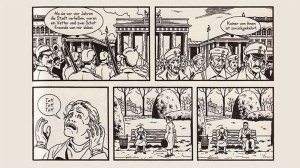

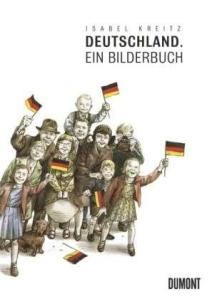

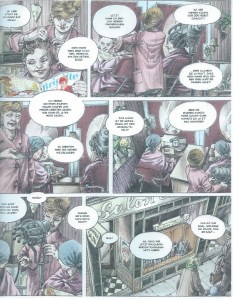










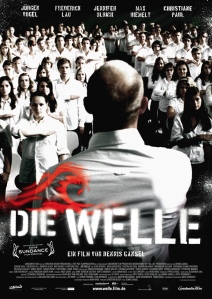

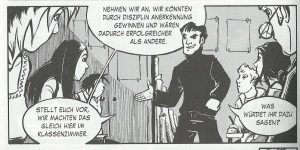



Hi! I am looking for a dramatic German Graphic novel depicting stories of German WWII soldiers from a personal, humanistic point of view. Iespecially remember one with a German soldier of Polish origin.
Do you know it?
Danke
Dimitris
Hi Dimitris,
I just did a search and found some that may be appropriate.
See: http://www.tagesspiegel.de/kultur/comics/neue-comics-ueber-den-zweiten-weltkrieg-das-leid-der-vaeter/9031744.html
oder auch: https://www.goethe.de/de/kul/lit/20546406.html
Please also let me know if you find some new ones.